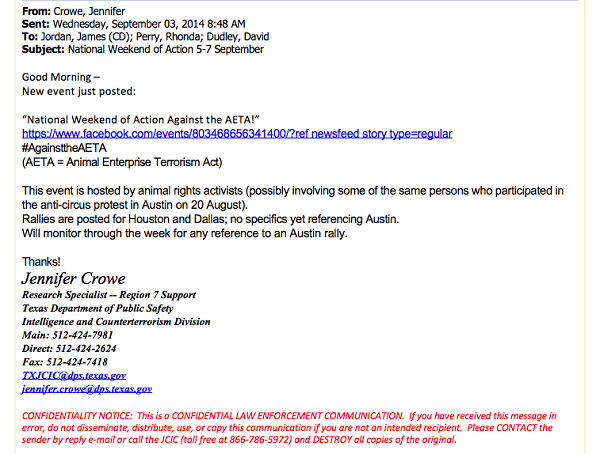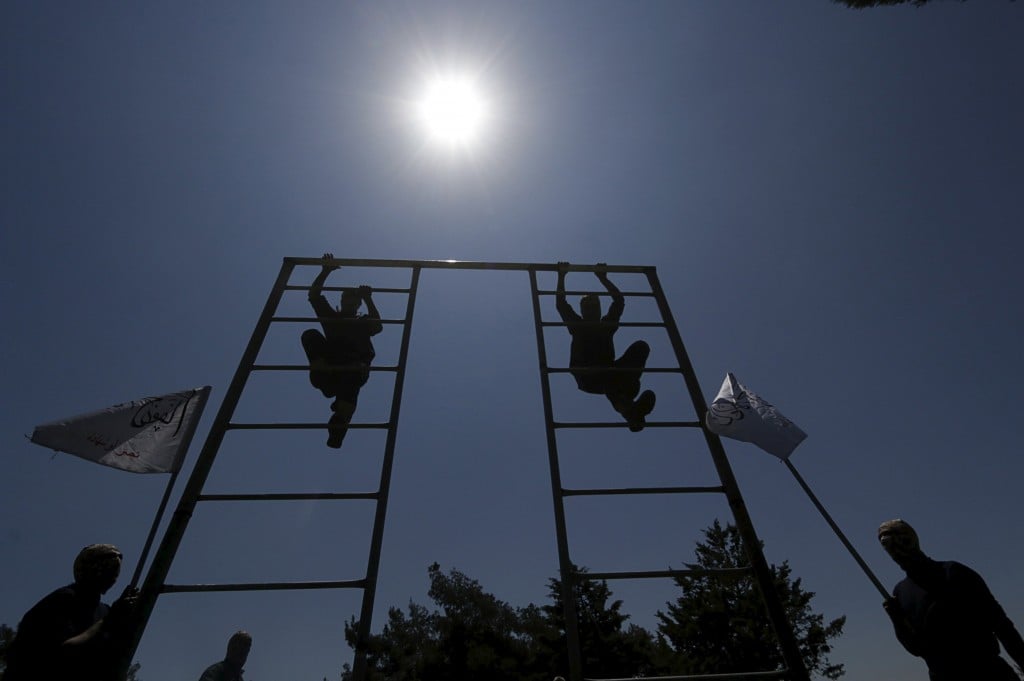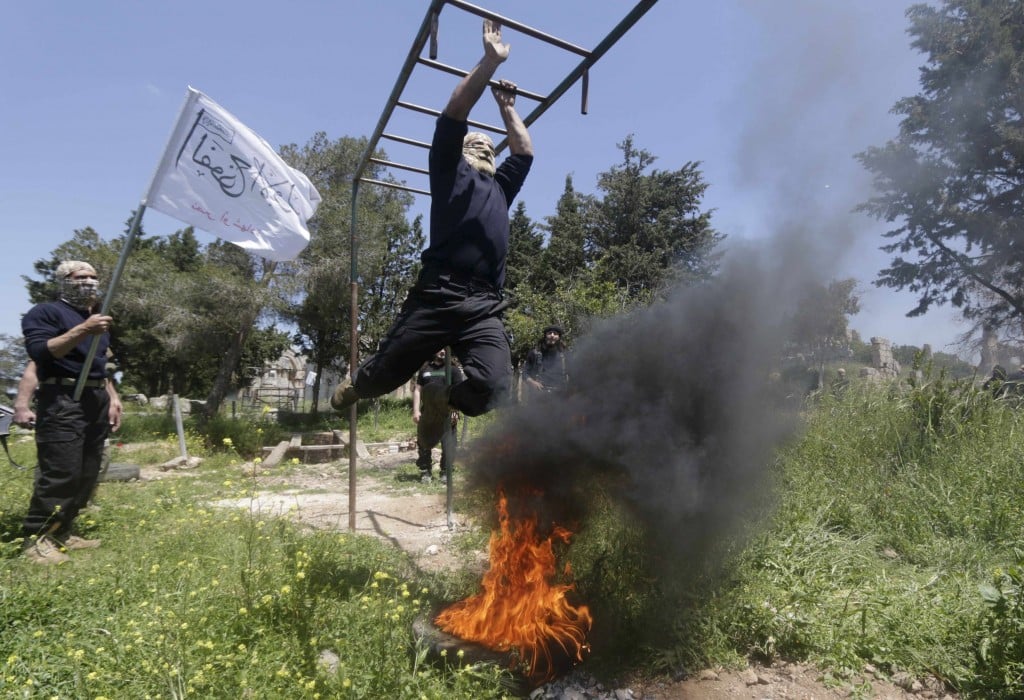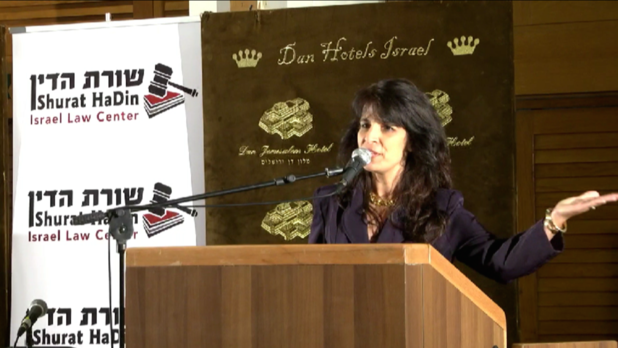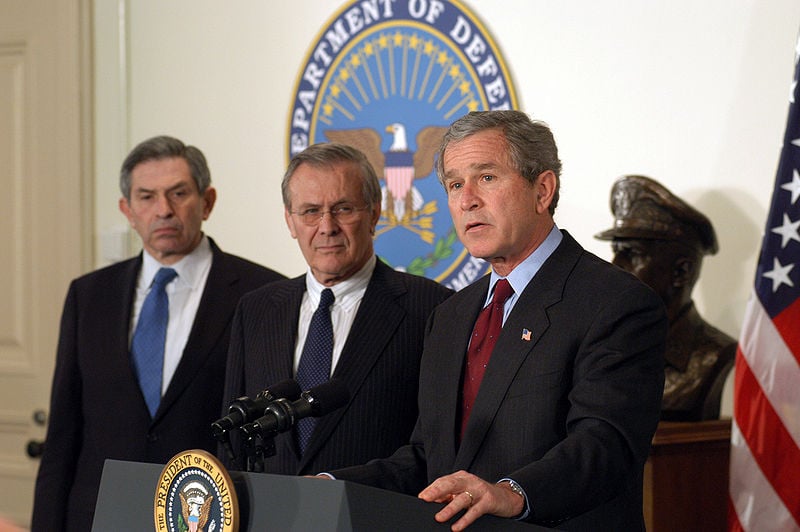Deux ans après sa victoire sur la Wehrmacht et le nazisme, la « Guerre froide » officiellement installée, l’Armée rouge, chérie de tous les peuples européens depuis juin 1941, passa chez ceux de l’« Ouest » pour une menace[1]. Aujourd’hui, l’historiographie française, sa mutation pro-américaine vieille de trente ans achevée, voue l’URSS aux gémonies tant pour la phase du pacte de non-agression germano-soviétique que désormais pour celle de la « Grande guerre patriotique ». Nos manuels, assimilant nazisme et communisme, surenchérissent sur les historiens d’Europe orientale recyclés à l’Ouest. Les grands médias, qui encensent « les historiens du consensus »[2] à l’« « esprit dégagé de tout sectarisme »[3], ont transformé le débarquement « américain » (anglo-américain, Commonwealth inclus) du 6 juin 1944 en événement militaire décisif ( Lire en cliquant ici) . Martèlement efficace. Les sondages IFOP sur la contribution respective de l’URSS et des États-Unis à la conduite militaire de la Deuxième Guerre mondiale ou « à la victoire sur les nazis » se sont, entre mai 1945 et mai 2015, strictement inversés : 57% pour l’URSS à la première date (20% pour les États-Unis) ; 54% pour les États-Unis aujourd’hui, et jusqu’à 59% chez les moins de 35 ans[4], victimes prioritaires de la casse de l’enseignement de la discipline historique.
Cette inversion politique consacre le double triomphe, en France, de l’hégémonie américaine et d’une russophobie obsédante depuis 1917, limitée pendant plusieurs décennies par l’existence d’un parti communiste puissant et présent sur le terrain de l’histoire mais considérablement accentuée par la chute de l’URSS. Elle est sans rapport avec le tableau que dressent les sources originales du rôle joué par l’URSS dans la Deuxième Guerre mondiale.
Du sabotage franco-anglo-polonais de l’Entente au pacte germano-soviétique
Ce que fit l’URSS quand le Blitzkrieg écrasa l’Europe (septembre 1939-mai 1941) a suscité depuis quelques décennies de nombreux travaux scientifiques, anglophones surtout[5]. Ils renouent en général avec la thèse, solidement établie entre la guerre et les années 1960, des prestigieux Lewis B. Namier, A.J.P. Taylor (historiens) et du journaliste Alexander Werth[6], père de Nicolas, qui symbolisa autant la russophilie de guerre et d’après-guerre que son fils incarne la russophobie contemporaine.
La thèse en question est simple et factuelle. L’entêtement franco-anglais, soutenu par les États-Unis[7], dans la politique de capitulation face aux puissances fascistes baptisée « Apaisement » ruina le projet soviétique, clairement énoncé dès 1933-1934, de « sécurité collective » des pays européens, de l’Est et de l’Ouest, également menacés par la politique d’expansion du Reich allemand. Tuant dans l’œuf les pactes franco-soviétique et tchéco-soviétique (2 et 16 mai 1935), le rejet occidental obstiné de « l’alliance de revers » dont la Première Guerre mondiale avait démontré l’efficacité aboutit, contre l’URSS, aux accords de Munich par lesquels, dans la nuit du 29 au 30 septembre 1938, Paris, Londres, Berlin et Rome dépecèrent la Tchécoslovaquie (par la remise des Sudètes à l’Allemagne dès le 1er octobre 1938). Après l’assaut final, les 14-15 mars 1939 (satellisation de la Slovaquie et annexion de la Bohême-Moravie), porté par la Wehrmacht contre le moignon de l’ex-principale alliée officielle de la France, l’URSS isolée fut confrontée au maintien strict, malgré la légende d’un « tournant » franco-anglais de politique extérieure, d’une ligne laissant au Reich « les mains libres à l’Est » : cette expression familière à tous les « Apaiseurs », français, anglais et divers (dont le ministre de la Guerre puis président du Conseil radical Édouard Daladier) fut couramment utilisée dans les tractations de 1938-1939 entre les ministres des Affaires étrangères français et allemand, Georges Bonnet et Ribbentrop. L’URSS se résigna à signer le pacte germano-soviétique du 23 août 1939 qui l’épargnait provisoirement[8].
Ainsi s’achevait la mission franco-britannique envoyée à Moscou du 11 au 24 août 1936 pour calmer des opinions qui réclamaient depuis le 15 mars le front commun avec l’URSS que celle-ci proposait. Moscou, initiatrice de négociations tripartites depuis le coup de force achevant la Tchécoslovaquie, exigeait la reconstitution de l’alliance défensive automatique et réciproque de 1914. L’accord militaire devrait associer la Pologne et la Roumanie, fiefs du « cordon sanitaire » antibolchevique de 1919 dont Paris et Londres avaient en mars-avril 1939 « garanti » unilatéralement les frontières (sans la moindre intention de les défendre, ni par du matériel ni par des envois de troupes), et les Pays Baltes, vitaux pour la défense de « la Russie d’Europe » (Augustin-Antoine Palasse, attaché militaire français)[9].
Après des mois de tergiversations insultantes pour les Russes et mortelles pour les frontières des pays d’Europe, Londres et Paris déléguèrent face aux chefs militaires soviétiques l’amiral britannique Reginald Drax et le général français Joseph Doumenc. Ces deux officiers obscurs, « demandeurs » partis « les mains vides » (Doumenc) par un navire marchand fort lent (cinq jours de traversée), avaient reçu pour mission de faire porter aux Soviets seuls le chapeau de « la farce de Moscou » : l’objectif était, se flattait Londres, à l’heure où le Reich massait ses troupes aux frontières de la Pologne pour l’assaut imminent, de « laisser l’Allemagne sous la menace d’un pacte militaire anglo-franco-soviétique et gagner ainsi l’automne ou l’hiver en retardant la guerre ». Quand le Commissaire à la Guerre et commandant en chef de l’armée rouge Clément Vorochilov, « précis, direct », proposa à ces deux émissaires impotents, le 12 août, « “l’examen concret” des plans d’opérations contre le bloc des États agresseurs » et leur présenta ses pouvoirs plénipotentiaires, ils avouèrent n’être pas habilités à signer un accord militaire.
Paris et Londres étaient résolus à ne fournir aucune aide économique ou militaire à leurs « alliés » de l’Est. Ils avaient délégué la tâche à l’URSS en la lui rendant strictement impossible : Varsovie (surtout) et Bucarest (qui avaient depuis les années 1920 conclu des accords politico-militaires mutuels exclusivement tournés contre l’URSS) avaient toujours refusé droit de passage (avec leurs tuteurs occidentaux) à l’Armée rouge. Or cette clause constituait la condition géographique sine qua non de son intervention, puisque l’URSS n’avait pas de frontière commune avec l’Allemagne du traité de Versailles. Ayant « garanti » sans la consulter la Pologne (qui ne voulait pas de leur « garantie »), la France et le Royaume-Uni se prétendirent ligotés par le veto, qu’ils encourageaient, au su et au vu de tous, Soviétiques inclus, de la clique germanophile qui régnait à Varsovie. Digne émule de son « allié » allemand en matière d’antisémitisme, le chef du « régime des colonels polonais », le colonel Jozef Beck, petit télégraphiste d’Hitler et Ribbentrop auxquels il servait, entre autres, de délégué à et d’informateur sur la Société des Nations officiellement désertée par le Reich en octobre 1933, avait été la « hyène » ou le « vautour » (terme utilisé par toutes les chancelleries étrangères, dont l’Auswärtiges Amt, ministère des Affaires étrangères), complice du dépècement allemand de la Tchécoslovaquie de 1938.
Son inlassable vindicte contre Prague ‑ la même que celle de son chef et prédécesseur Pilsudski ‑ avait valu à la Pologne le pourboire, fugace, de l’octroi du territoire silésien de Teschen arraché à la Tchécoslovaquie après Munich : la récompense de ses méfaits dura moins d’un an, jusqu’à l’invasion allemande. La Wehrmacht aux portes, Beck invoquait, lyrique, « le testament » de Pilsudski : « Avec les Allemands nous risquons de perdre notre liberté, avec les Russes, nous perdons notre âme »[10].
Le dossier avait d’autres ressorts, moins spirituels. La Pologne avait saisi aux Soviets en 1920-1921 avec l’aide militaire française (Maxime Weygand, aidé notamment de De Gaulle) la Galicie orientale de l’ancien empire russe, peuplée d’Ukrainiens et de Biélorusses (l’actuelle Ukraine occidentale). Aveugle, depuis 1933 plus que jamais, aux appétits territoriaux allemands, persécutant allègrement les populations, majoritaires, non-polonaises, elle tremblait que l’Armée rouge ne prît aisément le contrôle de ces territoires sis 150 km à l’Est de la « ligne Curzon » : cette limite ethnique entre Pologne et Russie avait été fixée en décembre 1919 par le Foreign Office, certain de chasser bientôt du pouvoir les bolcheviques et disposé à affecter cette zone aux « Blancs », puisque ceux-ci l’étaient à céder les richesses du Caucase (Bakou et Grozny) à la Royal Dutch Shell de Sir Henry Deterding : ce héraut de l’anticommunisme pétrolier, bailleur de fonds de tous les complots « tchétchènes » de l’entre-deux-guerres jusqu’à sa mort (4 février 1939) et grand fournisseur de pétrole au IIIème Reich, appréciait tant ce régime et ses chefs qu’il résidait à Berlin depuis sa retraite officielle de 1936.
Varsovie avait signé avec Berlin, le 26 janvier 1934, une « déclaration de non-agression et d’amitié », prétendu « traité germano-polonais » conclu pour dix ans. Rédigé par l’Auswärtiges Amt, ce chiffon de papier lui interdisait formellement, entre autres prescriptions, tout accord avec l’URSS et avec ses voisins slaves : elle appliqua scrupuleusement pour sa part toutes les clauses, russophobes et antisémites en tête, d’un texte qui s’insérait dans le dispositif général préparant, au su et au vu de ses « alliés » occidentaux, sa liquidation territoriale. La Roumanie redoutait de perdre la Bessarabie qu’elle n’avait prise aux Russes en 1918 et conservée depuis (officiellement, en 1924) que grâce au soutien de la France chef de file officiel, avec Londres, de l’antibolchevisme mondial. On doit cependant admettre qu’elle éprouvait plus de craintes à l’égard du Reich que la clique des colonels et des grands hobereaux polonais historiquement attachés à la tutelle autrichienne et prussienne. L’URSS n’obtint pas non plus des Apaiseurs français et anglais « garantie » des frontières des Pays Baltes, dont l’« indépendance » avait tout dû depuis 1919-1920 à l’établissement du « cordon sanitaire ». Paris et Londres ricanaient volontiers sur ces demandes depuis mars-avril 1939 : en compagnie des ambassadeurs américains, ils accusaient Moscou de ne songer qu’à « bolcheviser » ces satellites de fait (et de longue date) du Reich[11].
L’URSS était depuis mars et surtout mai 1939 courtisée par Berlin qui préférait logiquement une guerre sur un front, celle sur deux fronts lui ayant valu sa précédente défaite. L’Allemagne lui promit, juste avant de fondre sur la Pologne, de respecter sa « sphère d’influence » en Galicie orientale, en Baltique et en Bessarabie. Moscou céda à ses pressantes instances, au tout dernier moment (Geoffrey Roberts l’a montré dès ses premiers travaux), et pas à des fantasmes imaginaires de « révolution mondiale », mythe de « Drang nach Westen » (marche vers l’Ouest) forgé pour faire oublier la seule marche qui eût jamais eu lieu, celle, allemande, vers l’Est[12]. Londres et Paris continuant à cajoler Berlin[13], l’Union Soviétique refusait d’« être impliquée toute seule dans un conflit avec l’Allemagne » : c’était sa seule préoccupation, comme l’avoua, en mai 1939, Lord Halifax, secrétaire au Foreign Office et parangon de l’Apaisement britannique[14]. Le 23 août 1939, à la signature du pacte de non-agression germano-soviétique, l’« Occident » mima la stupeur, tel Churchill, devant « la sinistre nouvelle explosant sur le monde comme une bombe »[15] : c’est ainsi que ce chef de la coalition antisoviétique depuis 1918, qui n’avait abdiqué l’Apaisement qu’assez récemment, dénonça la volte-face, la trahison, le long mensonge de l’antifascisme du nouvel « allié » de Berlin.
L’indignation, feinte, relevait de l’imposture. Diplomates et attachés militaires français et anglais en poste à Moscou jouaient les Cassandre depuis l’arrivée des hitlériens au pouvoir, début 1933. Faute de Triple Entente et donc d’alliance de revers défensive et formelle, avaient-ils régulièrement répété depuis lors, l’URSS serait contrainte de composer momentanément avec Berlin : c’était pour elle le seul moyen de gagner le « répit » (Roberts) indispensable à la mise sur pied de guerre, la moins imparfaite possible, de son économie et de son armée face à un adversaire allemand à cette date encore très supérieur. Le plus souvent très antibolcheviques mais factuels, ces informateurs pertinents réitérèrent leur mise en garde jusqu’au dernier jour[16], et annoncèrent ensuite que le pacte ne changeait rien aux enjeux. Le 29 août 1939, le lieutenant-colonel Charles-Antoine Luguet, attaché aérien à Moscou et futur héros gaulliste de l’escadrille Normandie-Niémen, certifia (comme Doumenc) la bonne foi de Vorochilov et posa Staline en « glorieux successeur […] d’Alexandre Nevsky et de Pierre Ier » : « le traité publié est », écrivit-il, « complété par une convention secrète, définissant, à distance des frontières soviétiques, une ligne que les troupes allemandes ne devront pas dépasser et qui serait considérée par l’URSS en quelque sorte comme sa position de couverture. »[17]. Un « protocole secret » intégra en effet la Pologne orientale et les États baltes à la « sphère d’influence » de l’URSS[18], avec pour objectif immédiat d’améliorer les conditions et la durée de sa mobilisation, et d’occuper un terrain qui serait, pendant les ultimes préparatifs de l’assaut allemand, soustrait à la Wehrmacht.
Français et Anglais ne manqueraient pas d’observer, après coup, que l’Armée rouge n’était entrée en Pologne (le 17 septembre 1939) qu’après la défaite officielle de celle-ci, puis en Bessarabie et dans les Pays Baltes qu’en juin 1940, après la Débâcle de la France[19].
L’URSS en paix dans la guerre
L’Allemagne ouvrit le conflit général le ler septembre 1939 en l’absence de l’Entente qui avait en septembre 1914 sauvé la France de l’invasion totale. Michael Carley incrimine l’Apaisement né de « la peur de la victoire contre le fascisme » des privilégiés anglais et français, effrayés que le rôle dirigeant promis à l’URSS dans une guerre contre l’Allemagne n’étendît son système à tous les belligérants : il considère donc « l’anticommunisme », décisif à chaque phase-clé depuis 1934-35, comme « une cause importante de la Seconde Guerre mondiale »[20].
Le 17 septembre, l’URSS, accablée par l’avance allemande en Pologne, qui avait été vaincue en moins de 24 heures – pour la France, ce serait moins de 48 ‑, proclama sa « neutralité » dans le conflit et occupa la Galicie orientale. Elle exigea en septembre-octobre de Berlin des « garanties » des Pays Baltes : cette « occupation “déguisée” [fut] accueillie avec résignation » par l’Angleterre. Celle-ci avait secondé le Reich dans son plan d’assaut maritime contre l’URSS en signant avec lui « le traité naval » du 18 juin 1935 : autorisant la construction d’une marine de guerre allemande égale à 35% de la britannique, cet accord bilatéral avait laissé à l’Allemagne « les mains libres » en Baltique (Finkel et Leibovitz). Mais Londres s’inquiétait désormais autant de l’expansion allemande que « la poussée russe en Europe »[21].
Après avoir requis de la Finlande, alliée de longue date de Berlin qui menaçait la sécurité de Leningrad, une rectification de frontière (contre substantielle compensation territoriale) qui lui fut refusée, l’URSS entra fin novembre 1939 dans « la guerre d’hiver ». Les tambours de la propagande se déchaînèrent : la France sanglota autant que le Vatican et l’ensemble du monde (capitaliste) sur la petite victime et elle exalta sa vaillance contre une Armée rouge inepte. Weygand et Daladier suivi de Reynaud planifièrent, « rêve » puis « délire », une guerre contre l’URSS dans le Grand Nord puis dans le Caucase[22], en même temps qu’ils continuaient à saboter, comme les chefs de l’armée, le « front du Nord-Est » : surnom pompeux de la frontière française avec l’Allemagne, où, précisément, il n’y avait aucun « front ». L’Angleterre sacrifia à l’idéologie anticommuniste, si utile en toutes circonstances, mais elle applaudit le compromis finno-soviétique du 12 mars 1940. Elle se félicita ensuite de la nouvelle avance de l’Armée rouge consécutive à l’ignominieux effondrement français, c’est-à-dire de l’occupation à la mi-juin 1940 des Pays Baltes, fin juin de la Bessarabie-Nord Bucovine. Puis, dans l’attente de l’étape suivante du conflit général, elle délégua à Moscou Stafford Cripps, seul soviétophile d’un establishment britannique à l’antisoviétisme au moins aussi délirant que celui des élites françaises[23].
En crise ouverte depuis juin 1940, les rapports des prétendus « Alliés » allemands et soviétiques frôlèrent la rupture en novembre, comme le surent toutes les capitales « occidentales ». « Entre 1939 et 1941 », l’URSS avait considérablement développé ses armements terrestres et aériens et porté l’armée rouge « de 100 à 300 divisions » (« de 2 à 5 millions d’hommes »), massées « le long ou près de ses frontières occidentales. »[24]
La victoire militaire d’un pays affaibli
Le 22 juin 1941, le Reich lança l’attaque qu’annonçait depuis septembre 1940 l’entassement de ses troupes en Roumanie « satellite », connu de toutes les capitales étrangères – et de l’URSS, Staline inclus : le dernier ouvrage de Roberts fait définitivement litière de la légende du Staline sidéré et paralysé par l’assaut de son cher Hitler. Nicolas Werth postule « l’effondrement militaire de 1941 » auquel aurait succédé (en 1942-1943) « un [mystérieux] sursaut du régime et de la société »[25], mais, à Vichy, le général Paul Doyen, chef de la délégation française à la Commission allemande d’armistice, annonça le 16 juillet 1941 la mort du Blitzkrieg et donc, la défaite allemande très probable si l’incroyable résistance soviétique durait, ce que tout laissait prévoir : « Si le IIIème Reich remporte en Russie des succès stratégiques certains, le tour pris par les opérations ne répond pas néanmoins à l’idée que s’étaient faite ses dirigeants. Ceux-ci n’avaient pas prévu une résistance aussi farouche du soldat russe, un fanatisme aussi passionné de la population, une guérilla aussi épuisante sur les arrières, des pertes aussi sérieuses, un vide aussi complet devant l’envahisseur, des difficultés aussi considérables de ravitaillement et de communications […] Sans souci de sa nourriture de demain, le Russe incendie au lance-flamme ses récoltes, fait sauter ses villages, détruit son matériel roulant, sabote ses exploitations »[26]. Le Vatican, meilleur réseau de renseignement mondial, s’alarma début septembre devant l’ambassadeur de France des difficultés « des Allemands » et d’une issue « telle que Staline serait appelé à organiser la paix de concert avec Churchill et Roosevelt »[27] : il situa donc « le tournant de la guerre » avant l’arrêt de la Wehrmacht devant Moscou (fin octobre) et bien avant Stalingrad. L’ensemble des milieux « bien informés », militaires et civils, partagea ce jugement, et au même moment[28].
Fut ainsi confirmé dès l’invasion le jugement que portait Palasse depuis son arrivée (fin 1937) et surtout depuis 1938 sur « la situation morale » et la puissance militaire soviétiques. L’armée rouge, épurée après la répression, en juin 1937, du « complot Toukhatchevski » concocté par le Maréchal soviétique avec le haut commandement de la Wehrmacht, avéré et non forgé par Staline[29], progressait constamment. Ses liens avec le peuple généraient un « patriotisme » inouï : statut de l’armée, formation militaire des soldats et de la population, jeunesse en tête, et propagande efficace « mainten[aient] tendues les énergies du pays, et lui donn[aient] l’orgueil des exploits accomplis par les siens […] et la confiance inébranlable dans [s]a force défensive. »[30] Il avait comme tous les autres observateurs militaires relevé depuis août 1938 les défaites nippones dans les affrontements à la frontière URSS-Chine-Corée[31]. La qualité, ainsi attestée, de l’armée rouge conduite par Joukov, servit de leçon à Tokyo : à la fureur d’Hitler, le Japon signa à Moscou le 13 avril 1941 un « pacte de neutralité », qu’il respecta jusqu’à la fin de la guerre. Ce prudent retrait japonais libéra l’URSS de son obsession, depuis l’attaque contre la Mandchourie (1931) puis toute la Chine (1937), d’une guerre sur deux fronts[32].
Après un 60e anniversaire historiquement aventuré du débarquement anglo-américain en Normandie et un 70e pire encore, rappelons que l’effort militaire fut depuis juin 1941 quasi uniquement soviétique. Le Reich impérial avait été en 1917-1918 défait à l’Ouest, surtout par la France, laquelle avait tout de même dû sa survie ou sa non-invasion à l’alliance de revers ou au « rouleau compresseur » russe et en aucun cas à la « bataille de la Marne », cette opération de « communication » à l’inusable longévité. Comme le rappelait en mars 1939 Robert Vansittart, sous-secrétaire d’État permanent du Foreign Office ‑ qui avait été aussi longtemps « Apaiseur » et germanophile que ses pairs : « La France n’aurait pas eu la moindre chance de survie en 1914, s’il n’y avait pas eu de front oriental. »[33] Le Reich hitlérien, arrêté depuis l’été 1941 dans ses succès ininterrompus depuis 1938-1939, fut vaincu de 1943 à 1945 à l’Est, par la seule Armée rouge.
Depuis août-septembre 1941, Staline avait réclamé sans répit mais en vain pour alléger l’énorme pression allemande l’ouverture d’un « second front » occidental reconstituant de fait l’alliance de revers de la Première Guerre mondiale : l’envoi de divisions alliées en URSS et, surtout, un débarquement sur les côtes françaises. Il dut se contenter des louanges de Churchill, bientôt suivi de celles de Roosevelt, sur « l’héroïsme des forces combattantes soviétiques » et d’un « Prêt-Bail » américain, remboursable après-guerre. Un historien soviétique en a évalué le montant total à 5 milliards de roubles (un historien américain à 11), soit « 4% du revenu national » soviétique des années 1941-1945[34]. Roberts a rappelé que cette contribution économique américaine à l’effort soviétique fut non seulement modeste, mais qu’elle ne fut accordée pour sa quasi-totalité qu’après l’extraordinaire exploit de Stalingrad – autrement dit, quand les États-Unis eurent acquis la certitude définitive que l’Armée rouge triompherait, dans des délais limités, des envahisseurs. Le refus obstiné du second front et la mise à l’écart de l’URSS des relations interalliées, malgré sa présence cosmétique à Téhéran en novembre 1943[35], sont attestés par tous les types de sources et par la correspondance de guerre Staline-Churchill-Roosevelt. Les objectifs et manœuvres des Anglo-Américains, guidés par Washington, ravivèrent légitimement la hantise soviétique du retour au « cordon sanitaire » et aux « mains libres à l’Est ».
La question des forces en Europe s’aiguisa quand la capitulation de von Paulus à Stalingrad (2 février 1943) mit à l’ordre du jour les conditions de la paix future. Washington comptait sur son hégémonie financière pour échapper aux normes militaires du règlement des conflits. Roosevelt refusait donc systématiquement de négocier sur « les buts de guerre » que Staline avait présentés à Churchill dès juillet 1941, c’est-à-dire le retour aux frontières européennes de l’ancien empire, récupérées en 1939-1940 : l’obtention d’une « sphère d’influence » soviétique limiterait l’américaine, qui ne pouvait souffrir aucune borne[36] (cette règle de l’impérialisme dominant fut strictement appliquée contre Londres : Washington émit un veto aussi formel contre ses rivaux impérialistes anglais). Le milliardaire Harriman, héritier d’un immense empire financier, ambassadeur à Moscou de 1943 à 1945 et futur champion du Plan Marshall et de l’Union européenne, annonça au Département d’État, en février-mars 1944, que l’URSS ravagée ne tirerait aucun avantage, même territorial, de sa victoire. « Appauvrie par la guerre et à l’affût de notre assistance économique […,] un de nos principaux leviers pour orienter une action politique compatible avec nos principes », elle n’aurait pas la force d’empiéter sur l’Est de l’Europe. Réduite à la misère par ses destructions, elle serait obligée de se satisfaire d’une promesse d’aide financière américaine pour l’après-guerre, ce qui nous permettrait « d’éviter le développement d’une sphère d’influence de l’Union Soviétique sur l’Europe orientale et les Balkans »[37].
Mais il fallut compter avec les conséquences de court terme de Stalingrad, où s’étaient affrontés depuis juillet 1942 « deux armées de plus d’un million d’hommes ». L’armée soviétique gagna cette « bataille acharnée », suivie avec passion au jour le jour par toute l’Europe occupée, qui « dépassait en violence toutes celles de la Première Guerre mondiale [,…] pour chaque maison, chaque château d’eau, chaque cave, chaque morceau de ruine ». Sa victoire « mit l’URSS sur la voie de la puissance mondiale », comme celle « de Poltava en 1709 [contre la Suède] avait transformé la Russie en puissance européenne »[38].
L’ouverture du « second front » traîna jusqu’en juin 1944, moment où l’avance de l’armée rouge au-delà des frontières de juillet 1940 de l’Union soviétique libérée exigea la répartition de fait des « sphères d’influence » que Roosevelt et les siens avaient récusées de droit. La conférence de Yalta qui, en février 1945, représenta l’acmé, très provisoire, des acquis de l’URSS, belligérant décisif, ne résulta pas de la ruse de Staline spoliant la Pologne martyre contre un Churchill impuissant et un Roosevelt mourant, mais du rapport de forces militaires du moment[39]. Or, il était en train de basculer dans la course-poursuite négociée de reddition de la Wehrmacht « aux armées anglo-américaines et de report des forces à l’Est » : fin mars, « 26 divisions allemandes demeuraient sur le front occidental » (pour évacuer par les ports du Nord les troupes vers les « bons » ennemis si indulgents) « contre 170 divisions sur le front de l’Est » où les combats firent rage jusqu’au bout. Les gains de Yalta engrangés sur le papier seraient donc promptement remis en cause, à commencer par le principe de 10 milliards de dollars de « réparations », soit 50% du total (pour des pertes estimées à plusieurs centaines de milliards, entre 200 et 600).
Le bilan de l’opération Sunrise, exemple le moins mal connu de tentatives de retournement des fronts qui se succédaient sans répit depuis 1943, dans l’alliance « Occident »-Reich contre les Soviets et avec une intensité fébrile depuis 1944, ulcéra Moscou. Roosevelt l’avait confiée au chef Europe de l’Office of Strategic Services (ancêtre de la CIA), installé depuis novembre 1942 à Berne pour préparer l’avenir de l’Europe en général, de l’Allemagne en particulier, le financier Allen Dulles, associé comme son frère aîné, John Foster, de « Dulles, Sullivan and Cromwell », un des principaux cabinets américains d’affaires internationales, intimement lié au capital financier allemand. Dulles, futur chef de la CIA d’Eisenhower et Kennedy (et héros du fiasco cubain de « la baie de Cochons »), négocia en mars-avril 1945, avec le général SS Karl Wolff, « chef de l’état-major personnel de Himmler » responsable de « l’assassinat de 300 000 juifs », la capitulation de l’armée Kesselring en Italie. Celle-ci eut lieu, en l’absence des Soviétiques, le 2 mai 1945[40].
Il était cependant politiquement exclu que Berlin tombât dans l’immédiat dans l’escarcelle des Occidentaux : du 25 avril au 3 mai, l’avant-dernière « sanglante bataille » (Prague, site de la dernière, ne tomba que le 9 mai)[41] tua encore 300 000 soldats soviétiques. Soit l’équivalent des pertes américaines totales, « militaires uniquement », des fronts européen et japonais de décembre 1941 à août 1945 [42].
La guerre allemande d’extermination
Selon Jean-Jacques Becker, « mise (sic) à part qu’elle s’est déployée sur des espaces bien plus vastes, mis à part le coût extravagant des méthodes de combat surannées de l’armée soviétique, sur un plan strictement militaire, la Seconde Guerre a été plutôt moins violente que la Première »[43]. Cette comparaison des deux guerres mondiales, hautement fantaisiste, impute en outre à l’URSS, accusation devenue courante dans l’historiographie dominante française, l’énormité de ses pertes (plus de la moitié des 50 millions du total général 1939-1945) dans la guerre d’extermination que le IIIème Reich avait planifiée pour y liquider, outre les juifs, trente à cinquante millions de Slaves[44]. La Wehrmacht, fief pangermaniste qui avait été aisément nazifié et qui tenait « les Russes [pour] des “asiates” dignes du mépris le plus absolu »[45], en fut l’artisan essentiel : sa sauvagerie anti-slave, antisémite et antibolchevique, décrite au procès de Nuremberg (1945-1946), brièvement rappelée en Allemagne par des expositions itinérantes de l’extrême fin du 20e siècle[46] et désormais, France incluse, ensevelie dans le silence, priva l’URSS des « lois de la guerre » (conventions de La Haye de 1907). À l’heure où l’on ose tout, la propagande médiatique estime la chose logique, l’URSS n’ayant pas signé ladite convention : pas signataires non plus, la Grèce, la Yougoslavie, la Pologne, l’Europe occidentale, objet, à l’été 1944, des consignes du commandant en chef « Ouest » de la Wehrmacht, von Rundstedt, étendant à cette zone les méthodes de guerre à l’Est, origine des atrocités commises en Italie et en France, des Oradour-sur-Glane qui avaient été systématiquement pratiqués, depuis l’origine, à des dizaines de milliers d’exemplaires, sur le front de l’Est [47] ?
Témoignent de la barbarie pangermaniste, dont le nazisme avait repris l’héritage, les ordres signés des chefs de la Wehrmacht, Keitel et consorts : le décret dit « du commissaire » du 8 juin 1941 prescrivit l’exécution des « commissaires politiques » communistes intégrés à l’armée rouge ; l’ordre de « ne pas faire de prisonniers » causa l’exécution sur le champ de bataille, combats terminés, de 600 000 prisonniers de guerre, et il fut étendu en juillet aux « civils ennemis » ; von Reichenau signa l’ordre d’« extermination définitive du système judéo-bolchevique », etc.[48] 3,3 millions de prisonniers de guerre, soit plus des 2/3 du total, subirent en 1941-1942 la « mort programmée » par la famine et la soif (80%), le typhus, le travail esclave. Des prisonniers, qualifiés de « communistes fanatiques », livrés par la Wehrmacht à la SS, furent les cobayes du premier gazage au Zyklon B d’Auschwitz en décembre 1941[49].
L’armée allemande fut avec les SS et la police allemande « ordinaire » un agent particulièrement actif de la destruction des civils, juifs et non-juifs. Elle aida les Einsatzgruppen SS chargés des « opérations mobiles de tueries » (Hilberg), comme celle du groupe C dans le ravin de Babi Yar, fin septembre 1941, dix jours après l’entrée de ses troupes à Kiev (près de 34 000 morts) : ce fut un des innombrables massacres perpétrés, avec des « auxiliaires » polonais, baltes (lettons et lituaniens) et ukrainiens[50], décrits par le poignant Livre noir sur l’extermination scélérate des juifs par les envahisseurs fascistes allemands dans les régions provisoirement occupées de l’URSS et dans les camps d’extermination en Pologne pendant la guerre de 1941-1945[51]. Slaves et juifs (1,1 million sur 3,3) périrent dans les dizaines de milliers d’Oradour-sur-Glane et dans les camps d’extermination et de travail. Les 900 jours de siège de Leningrad (juillet 1941-janvier 1943), symbole suprême avec Stalingrad des souffrances et de l’héroïsme soviétiques, tuèrent un million d’habitants sur 2,5, dont « plus de 600 000 » durant la famine de l’hiver 1941-1942. « 1 700 villes, 70 000 villages et 32 000 entreprises industrielles furent rasés ». Un million d’Ostarbeiter (« travailleurs de l’Est », soviétiques) déportés vers l’Ouest furent épuisés ou anéantis par le travail et les sévices des SS et des « kapos » dans les « kommandos » des camps de concentration, mines et usines des Konzerne et des filiales de groupes étrangers, tel Ford, fabricant (comme Opel-General Motors) des camions (allemands) 3 tonnes du front de l’Est[52].
Le 8 mai 1945, l’URSS exsangue avait déjà perdu le bénéfice de la « Grande Alliance » qu’avait imposée aux Anglo-Américains l’énorme contribution de son peuple, sous les armes ou non, à la victoire éclatante des États-Unis, prévue par Doyen dans son texte du 16 juillet 1941 pronostiquant la défaite allemande. Le prétendu « endiguement » (Containment) de la « Guerre froide » fut en réalité et d’emblée un « refoulement » (roll back), aujourd’hui éclairé par des travaux scientifiques. Désormais placée sous l’égide de Washington, avec rapide association à l’entreprise des zones occidentales de l’Allemagne, cette ligne avait renoué, avant même la fin de la guerre en Europe, avec la « Première Guerre froide », politique de liquidation des Soviets, de « cordon sanitaire » ou de « Sainte Alliance » que Londres et Paris avaient dirigée, en compagnie de Berlin, de 1918 à 1939[53].
Annie Lacroix-Riz
professeur émérite d’histoire contemporaine, Paris 7 – Mai 2015
Photo: Des soldats de l’Armée rouge devant la porte de Brandebourg, mai 1945.
Notes
[1] Annie Lacroix-Riz, « 1947-1948. Du Kominform au “coup de Prague”, l’Occident eut-il peur des Soviets et du communisme ? », Historiens et géographes (HG) n° 324, août-septembre 1989, p. 219-243.
[2] Diana Pinto, « L’Amérique dans les livres d’histoire et de géographie des classes terminales françaises », HG n° 303, mars 1985, p. 611-620 ; citation, Robert Soucy, historien américain du fascisme français, et Lacroix-Riz, L’histoire contemporaine toujours sous influence, Paris, Delga-Le temps des cerises, 2012.
[3] Le Figaro, 11 janvier 2007, recension d’Olivier Wieviorka, Histoire du débarquement en Normandie : Des origines à la libération de Paris 1941-1944, Paris, Seuil, 2007, ouvrage encensé par les médias et les institutions officielles comme celui niant l’intérêt militaire de la Résistance et omettant sa composante communiste, Histoire de la Résistance : 1940-1945, Paris, Perrin, 2013.
[4] Sondages 1944-1945 et 2004, Lacroix-Riz, « Le débarquement du 6 juin 1944 du mythe d’aujourd’hui à la réalité historique », http://www.lafauteadiderot.net/Le-debarquement-du-6-juin-1944-du, juin 2014 ; 7 mai 2015, http://www.metronews.fr/info/sondage-exclusif-8-mai-1945-a-qui-les-fra…
[5] Geoffrey Roberts, The Unholy Alliance : Stalin’s pact with Hitler, Londres, Tauris, 1989 ; The Soviet Union and the origins of the Second World War. Russo-German Relations and the Road to War, 1933-1941, New York, Saint Martin’s Press, 1995 ; et surtout, Stalin’s Wars : From World War to Cold War, 1939-1953. New Haven & London : Yale University Press, 2006, enfin traduit, Les guerres de Staline, Paris, Delga, 2014 ; Gabriel Gorodetsky, Soviet Foreign Policy, 1917-1991 : a retrospective, Londres, Frank Cass, 1993 (dont Teddy J. Uldricks, « Soviet Security in the 1930s ») ; Michael J. Carley, 1939, the alliance that never was and the coming of World War 2, Chicago, Ivan R. Dee, 1999 (traduit en français, PU de Montréal, 2001) ; Hugh Ragsdale, The Soviets, the Munich Crisis, and the Coming of World War II, Cambridge, Cambridge UP, 2004 ; Jonathan Haslam, The Soviet Union and the struggle for collective security in Europe, 1933-1939, Londres, Macmillan Press Ltd, 1984, plus timide.
[6] Lewis B. Namier, Diplomatic Prelude 1938-1939, Macmillan, Londres, 1948 ; A.J.P. Taylor, The origins of the Second World War, Middlesex, Penguin Books,1961 ; Alexander Werth, La Russie en guerre, 2 vol., Paris, Stock, 1964 (réédition, Paris, Tallandier, 2011).
[7] Arnold Offner, American Appeasement : United States Foreign Policy and Germany 1933-1939, New York, W.W. Norton & C°, 1969 ; The origins of the Second World War : American Foreign Policy, 1914-1941, New York, Praeger, 1975.
[8] Roberts, op. cit. et « From détente to partition : Soviet-Polish Relations and the origins of the Nazi-Soviet pact, 1938-1939 » in Christoph Koch, éd., Gab es einen Stalin-Hitler-Pakt ? Charakter, Bedeutung und Deutung des deutsch-sowjetischen Nichtangriffsvertrags vom 23. August 1939 » (« Y eut-il eu un pacte Staline-Hitler ? Caractère, signification et interprétation du pacte de non-agression germano-soviétique »), Francfort, Peter Lang, 2015, p. 89-106 ; Lacroix-Riz, Le choix de la défaite : les élites françaises dans les années 1930, et De Munich à Vichy, l’assassinat de la 3e République, 1938-1940, Paris, Armand Colin, 2010 (2e édition) et 2008 ; et « La France entre accord avec le Reich et alliance tripartite, de Munich au pacte de non-agression germano-soviétique (octobre 1938-23 août 1939) », in Koch, éd., Stalin-Hitler-Pakt ?, p. 35-88 ; Ivan Maïski, Qui aidait Hitler ? Souvenirs de l’ancien ambassadeur d’URSS en Grande-Bretagne, Paris, Delga, 2014 ; appuyé sur des archives (soviétiques) concordantes.
[9] Lettre 585/S à Édouard Daladier (ministre de la Guerre), Moscou, 5 juin 1939, 7 N, 3123, archives Armée de terre (SHAT), et références de la n. 7.
[10] Rapports Doumenc et Willaume (souligné dans le texte) sur leur mission, 7 N, 3185, SHAT. Sur le rôle de la Pologne, réf. n. 7 et Lacroix-Riz, « Polen in der außenpolitischen Strategie Frankreichs (Oktober 1938-August 1939) », communication au colloque sur la campagne de Pologne, Varsovie, 15-17 octobre 2009, Actes non parus, Polen und wir, n° 3, 2014, p. 11-17 (version française, « La Pologne dans la stratégie politique et militaire de la France (octobre 1938-août 1939) », www.historiographie.info).
[11] Archives MAE (et Documents diplomatiques français), SHAT, et références de la n. 7.
[12] Plan d’expansion soviétique à l’Ouest forgé par le publiciste d’extrême droite Ernst Nolte, cautionné par Yves Santamaria, Le pacte germano-soviétique, Bruxelles, Complexe, 1999, ouvrage rédigé sans la moindre consultation d’archives, qui sert de référence sur la question à l’historiographie dominante française.
[13] N. 3, Robert A. Parker, Chamberlain and the Appeasement : British policy and the coming of the Second World War,, Londres, Macmillan Press Ltd, 1993, et Alvin Finkel et Clement Leibovitz, The Chamberlain-Hitler Collusion, Rendlesham, Merlin Press, 1997.
[14] Halifax, 6 mai 1939, Documents on British Foreign Policy (DBFP), 3nd Series, V, p. 411.
[15] Churchill, mémoires, vol. I, The gathering storm, Boston, Houghton Mifflin Company, 1948, p. 346.
[16] 7 N, 3185-3186, SHAT. Depuis 1933 : série URSS Quai d’Orsay (MAE) ; DDF ; attachés militaires en URSS du SHAT ; DBFP, etc. et tous les op. cit.
[17] Lettre D. 463 à Guy de la Chambre, ministre de l’Air, Moscou, 29 août 1939, 7 N, 3186, SHAT.
[18] Lituanie acquise au Reich jusqu’au second protocole du 28 septembre 1939, Roberts, Soviet Union.
[19] Tél. Palasse, Moscou, 14 mai 1940, 5 N, 581, SHAT, et Roberts, Soviet Union, p. 122-126.
[20] Carley, 1939, p. 256-257 ; Finkel, Leibovitz et Lacroix-Riz, op. cit.
[21] Lettre 771 de Charles Corbin, ambassadeur à Londres, 28 octobre 1939, URSS 1930-1940, 962, archives du ministère des Affaires étrangères (MAE).
[22] Jean-Baptiste Duroselle, L’Abîme 1939-1945, Paris, Imprimerie nationale, 1983, chap. IV. Lacroix-Riz, op. cit. et Le Vatican, l’Europe et le Reich 1914-1944, Paris, Armand Colin, 2010, chap. 10.
[23] Gabriel Gorodetsky, Stafford Cripps’ mission to Moscow, 1940-42, Cambridge, Cambridge UP,1984., Maïski, Qui aidait Hitler ?
[24] G. Roberts, The Soviet Union, p. 122-134 et 139, et Les guerres de Staline.
[25] Omer Bartov et al., Les sociétés en guerre 1911-1946, Paris, Armand Colin, 2003, p. 134-144 (manuel de concours).
[26] Annexe au rapport 556 de Doyen à Koeltz, Wiesbaden, 16 juillet 1941, W 3, 210 (dossier Laval d’instruction de la Haute Cour de Justice), AN.
[27] Tardini, troisième personnage de la Curie, lettre de Léon Bérard, 4 septembre 1941, Vichy-Europe, 551, MAE.
[28] Cas français, Lacroix-Riz, Du Blitzkrieg à la Pax Americana : les élites françaises d’un tuteur étranger à l’autre, à paraître, Paris, Armand Colin, 2016, chap. 6.
[29] Sources diplomatiques et militaires internationales formelles sur cet accord de cession de l’Ukraine en échange de l’invasion allemande qui chasserait le pouvoir soviétique, Lacroix-Riz, Choix, p. 395-409.
[30] Rapport 449 S, Moscou, 22 mars 1938, 7 N, 3123, et 1937-1940,7 N, 3123, 3143, 3184, 3186, SHAT (l’État-major, qui avait depuis l’affaire Toukhatchevski enterré l’armée rouge après avoir refusé ses avances depuis 1935, cria au bolchevisme, Lacroix-Riz, Le choix).
[31] Palasse, août 1938, 7 N, 3123, courriers de Chine, 1938, 7 N, 3143, SHAT ; Documents on German Foreign Policy, D, II, p. 601, IV p. 609.
[32] Haslam, The Soviet Union and the Threat from the East, 1933-1941 : Moscow, Tokyo and the Prelude to the Pacific War, Londres, Macmillan, 1992 ; Roberts, Les guerres de Staline, et Stalin’s general : the life of Georgy Zhukov, London, Icon Books, 2012, chap. 4.
[33] Carley, 1939, p. 4, souligné dans le texte.
[34] M. L. Tamarchenko, 1967, et L. Martel, 1979, cités par Susan J. Linz, « Foreign aid and Soviet postwar recovery », The Journal of Economic History, v. XLV, n° 4, décembre 1985, p. 949.
[35] Foreign Relations of the United States (FRUS), The Conferences at Cairo and Tehran, 1943, Washington, US Government Printing Office, 1943, p. 457-891.
[36] Lynn E. Davis, The Cold War begins : Soviet-American conflict over Eastern Europe, 1941-1945, Princeton, Princeton UP, 1974 ; Lloyd Gardner, Spheres of influence. The great powers partition Europe, from Munich to Yalta, 1938-1945, Chicago, Ivan R. Dee, 1993 ; Lacroix-Riz, Vatican, chap. 10-11 ; « Le débarquement du 6 juin » ; Aux origines du carcan européen, 1900-1960. La France sous influence allemande et américaine, Paris, Delga-Le temps des cerises, 2014.
[37] Tél. Harriman, Moscou, 13 mars 1944, FRUS, 1944, IV, Europe, p. 951 (en ligne).
[38] Lloyd Gardner, Spheres of influence, p. 103, 148, 158-159 (cite l’historien militaire américain John Erickson, référence de Roberts) ; général Doer, cité par le colonel Costantini, Dictionnaire de la Seconde Guerre mondiale, t. 2, Paris, Larousse, 1980, p. 1728 ; et surtout Roberts, Les guerres de Staline.
[39] FRUS. Conferences at Malta and Yalta, Washington, USGPO, 1945, p. 547-996, et Diana Clemens, Yalta, New York, Oxford UP, 1970.
[40] Tom Bower, Blind eye to murder. Britain, America and the purging of Nazi Germany, a pledge betrayed, London, André Deutsch, 1981, p. 249, ouvrage essential, pas traduit à cette date ; Raul Hilberg, La destruction des juifs d’Europe, Paris, Gallimard, 1991, p. 958 ; fonds OSS cités par Richard Breitman, « Nazi Espionage : the Abwehr and SD Foreign Intelligence », p. 108 (93-118), in Breitman, Norman J. W. Goda, Timothy Naftali et Robert Wolfe, U.S. Intelligence and the Nazis, Cambridge University Press, 2005, fondamental ; Lacroix-Riz, « États-Unis et Vatican dans les tractations de paix de la Deuxième Guerre mondiale », Rencontres d’histoire critique de Gennevilliers 28-30 novembre 2013, « Guerre et paix », Actes à paraître, Paris, L’Harmattan, 2015.
[41] Gabriel Kolko, The Politics of War. The World and the United States Foreign Policy, 1943-1945, New York, Random House, 1969, rééd. 1990, chap. 13-14 (dont 375-378) ; Century of war : politics conflict and society since 1914, New York, New Press, 1994 ; Alexander Werth, La Russie en guerre, v. 2, p. 255-256.
[42] 292 000, Pieter Lagrou, in Stéphane Audoin-Rouzeau et al., dir., La violence de guerre 1914-1945, Bruxelles, Complexe, 2002, p. 322.
[43] Dont il est spécialiste (pas de la Deuxième Guerre mondiale), « Retour sur la comparaison et réflexion sur les héritages », in Stéphane Audoin-Rouzeau et al., dir., La violence de guerre 1914-1945, Complexe, Bruxelles, 2002, p. 333 (bréviaire de la préparation de la question d’histoire contemporaine CAPES-agrégation 2003-2005).
[44] Götz Aly et Susanne Heim, Vordenker der Vernichtung, Auschwitz und die deutschen Pläne für eine neue europäische Ordnung, Francfort, Fischer Taschenbuch Verlag, 1997 (1e édition, Hambourg, 1991, la plus audacieuse), résumé par Dominique Vidal, Les historiens allemands relisent la Shoah, Bruxelles, Complexe, 2002, p. 63-100.
[45] Rapport 1103 de l’attaché militaire français Henri-Antoine Didelet, Berlin, 12 décembre 1938, 7 N, 3097, SHAT.
[46] Édouard Husson, Comprendre Hitler et la Shoah. Les historiens de la RFA et l’identité allemande, Paris, PUF, 2000, p. 239-253.
[47] « Report on German Reprisals for Partisan activity in Italy », Allied Force Headquarters (British Section), Part I, sans date, postérieur au 9 juillet 1945, démonstration précise formelle de la responsabilité première de la Wehrmacht (et non des seuls Waffen SS), comme à l’Est, dans les atrocités commises à l’Ouest, BB 30, 1730, épuration, Archives nationales.
[48] Bower, Blind eye to murder ; Bartov, The Eastern Front, 1941-45 : German Troops and the Barbarisation of Warfare, Palgrave Macmillan, 2e édition, 2001 (L’armée d’Hitler […], Paris, Hachette, 2003) ; http://fr.wikipedia.org/wiki/Crimes_de_guerre_nazis_en_Union_sovi%C3%A9tique, mise au point honnête, ce qui, en histoire, n’est pas le cas général.
[49] Bower, Blind eye ; Christian Streit, Keine Kameraden. Die Wehrmacht und die sowjetischen Kriegsgefangenen 1941-1945, Bonn, Dietz, 1992 (1e éd., 1978) ; Christian Gerlach, Krieg, Ernährung, Völkermord. Forschungen zur deutschen Vernichtungspolitik im Zweiten Weltkrieg, Hambourg, Hamburger Edition, 1998 ; Peter Longerich, Politik der Vernichtung. Eine Gesamtdarstellung der nationalsozialistischen Judenverfolgung, Munich, Piper Verlag, 1998 ; Vidal, Les historiens.
[50] Hilberg, La destruction, Dieter Pohl, National-sozialistische Judenverfolgung in Ostgalizien : 1941-1944 : Organisation und Durchführung eines staatlichen Massenverbrechens, Munich, Oldenbourg, 1997 (et divers travaux, dont Holocaust : die Ursachen, das Geschehen, die Folgen. Herder, Fribourg en Brisgau, 2000 ; Christopher Browning, Des hommes ordinaires. Le 101è bataillon de réserve de la police allemande et la Solution finale en Pologne, Paris, 10-18, 1994, et Nazi policy, Jewish Workers, German Killers, Cambridge, Cambridge UP, 2000.
[51] Ilya Ehrenburg et Vassili Grossman, Textes et témoignages, Arles, Actes Sud, 1995.
[52] Costantini, Dictionnaire de la Seconde Guerre mondiale, t. 2, p. 1081-1083 ; Arno Mayer, Les Furies, terreur, vengeance et violence, 1789, 1917, Paris, Fayard, 2002, p. 573 ; Reinhold Billstein et al., Working for the Enemy Ford, General Motors, and forced labor in Germany during the Second World War, New York, Berghahn Books, 2000.
[53] Joyce et G. Kolko, The Limits of Power. The World and the United States Foreign Policy 1945-1954, New York, Harper and Row, 1972 ; Carolyn Eisenberg, Drawing the Line. The American decision to divide Germany, 1944-1949, Cambridge, 1996, William A. Williams, The Tragedy of American Diplomacy, New York, Dell Publishing C°, 1972 (1e éd., 1959), etc. Lacroix-Riz, Carcan ; « Débarquement du 6 juin » ; « L’apport des “guerres de Staline” de Geoffrey Roberts à l’histoire de l’URSS : acquis et débats », préface à Roberts, Les guerres, et Jacques Pauwels, Le Mythe de la bonne guerre : les USA et la Seconde Guerre mondiale, Bruxelles, Éditions Aden, 2e édition, 2012, et leur bibliographie récente.




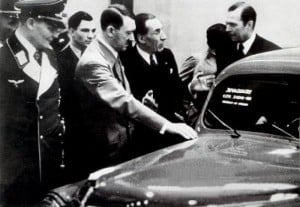
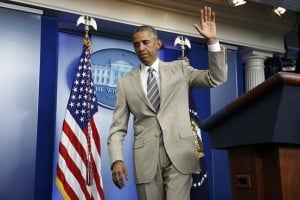
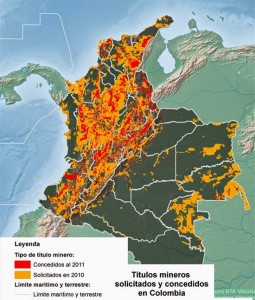










 “Musharraf won American support for the airlift by warning that the humiliation of losing hundreds-and perhaps thousands-of Pakistani Army men and intelligence operatives would jeopardize his political survival. ‘Clearly, there is a great willingness to help Musharraf,’ an American intelligen
“Musharraf won American support for the airlift by warning that the humiliation of losing hundreds-and perhaps thousands-of Pakistani Army men and intelligence operatives would jeopardize his political survival. ‘Clearly, there is a great willingness to help Musharraf,’ an American intelligen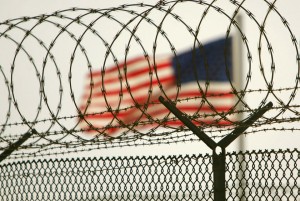
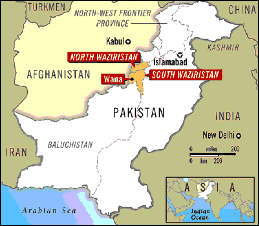
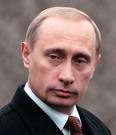


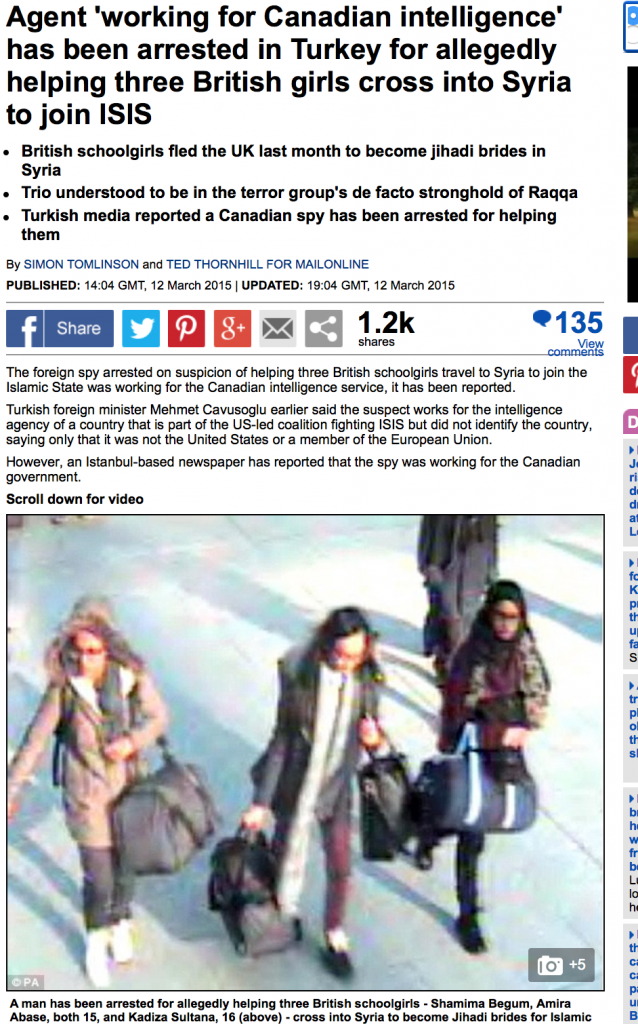

 So all praise to the few in our world who think it worth the bother to count those who count for nothing to us. They do matter.
So all praise to the few in our world who think it worth the bother to count those who count for nothing to us. They do matter.




